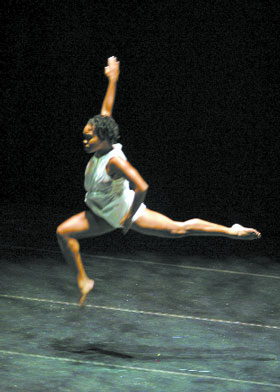Ronald K. Brown weds social consciousness to a diverse African tempo
Ronald K. Brown continues to mine the rich lode of West African dance movement, giving it his own postmodern spin and using it in the service of his highly developed social consciousness. His deep convictions about social equality for all races, genders, and sexual persuasions, motivate the stirring dances he creates for his company, Ronald K. Brown/Evidence.
His selection of repertoire for the troupe’s Joyce Theater season (October 21-26) reflected the evolution of his recent style: from black gay club dancing fused with modern dance in “High Life” (2000), to the almost purely West African vocabulary of “Walking Out the Dark” (2001), to a more sophisticated blend of continuously unfurling gesture in the premiere “Come Ye” that affirms his assimilation of all his sources.
Accompanied by a selection of music from Oscar Brown, Jr. to Nikki Giovanni to Africans Nkengas and Fela Kuti, “High Life” traces the journey of blacks from slaves on sale at auction to high-stepping club-goers to middle-class senior citizens. The piece brings to mind Alvin Ailey’s signature ballet “Revelations” in its keen evocation of the “black experience” in America.
Like Ailey––the latter twentieth century icon of black American modern dance––Brown is a physically beautiful man, a dynamic dancer, and a choreographer whose work touches audiences’ emotions strongly. In fact, in the past few years Brown has created highly successful ballets for the Alvin Ailey American Dancer Theatre.
But unlike Ailey, whose later dances increasingly strove to emulate mainstream Euro-American aesthetics—even creating a ballet, “The River,” for American Ballet Theatre—Brown proclaims his African-ness, his sexuality, and his spirituality without reservation or compromise.
West African movement and Afro-Cuban rhythms drive “Walking Out the Dark,” a life-affirming ritual. Four dancers—a different selection of men and women at each performance—face off across a square in assertive, but non-aggressive confrontations, then move along diagonals—a favorite spatial device of Brown’s—in a prayerful processional. At the Saturday matinee, Camille A. Brown, Juel Lane, Arcell Cabaug, Julian Lloyd, and Brown, who speaks his own poem, gave it a fine performance.
But Brown’s ubiquitous spirituality is neither sanctimonious nor dogmatic. His buoyant, robust movement is the kinesthetic equivalent of a revival meeting, where divine inspiration uplifts souls and bodies to a state of ecstatic joy. In “Come Ye” the eight glorious dancers, Cabaug, Lane, Camille Brown, Bridget Moore, Keon Tholouis, Shani Collins, Dierdre Dawkins, and Brown, begin spread across the stage, lit in silhouette by Brenda Dolan and dressed in elegant black clothes by Wunmi Olaiya.
They dance a complex counterpoint of individual phrases that make them distinct but still part of the group, “human heroes and sheroes,” as Brown puts it in his poetic program note. Soulful, angry songs by Nina Simone accompany the solos, duets, and trios that articulate the dance. The other dancers remain onstage witnesses, silently supporting their brothers and sisters. At the end, to the African rhythms of Kuti and backed by film images of civil rights protests along the unending march to equality, the dancers merge into a single line: an army of one, eight souls deep, united in a celebration of solidarity and hope.


































